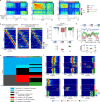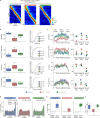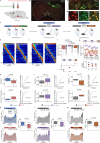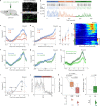Reward expectation extinction restructures and degrades CA1 spatial maps through loss of a dopaminergic reward proximity signal
- PMID: 36333323
- PMCID: PMC9636178
- DOI: 10.1038/s41467-022-34465-5
Reward expectation extinction restructures and degrades CA1 spatial maps through loss of a dopaminergic reward proximity signal
Abstract
Hippocampal place cells support reward-related spatial memories by forming a cognitive map that over-represents reward locations. The strength of these memories is modulated by the extent of reward expectation during encoding. However, the circuit mechanisms underlying this modulation are unclear. Here we find that when reward expectation is extinguished in mice, they remain engaged with their environment, yet place cell over-representation of rewards vanishes, place field remapping throughout the environment increases, and place field trial-to-trial reliability decreases. Interestingly, Ventral Tegmental Area (VTA) dopaminergic axons in CA1 exhibit a ramping reward-proximity signal that depends on reward expectation and inhibiting VTA dopaminergic neurons largely replicates the effects of extinguishing reward expectation. We conclude that changing reward expectation restructures CA1 cognitive maps and determines map reliability by modulating the dopaminergic VTA-CA1 reward-proximity signal. Thus, internal states of high reward expectation enhance encoding of spatial memories by reinforcing hippocampal cognitive maps associated with reward.
© 2022. The Author(s).
Conflict of interest statement
The authors declare no competing interests.
Figures





Similar articles
-
Ventral tegmental area disruption selectively affects CA1/CA2 but not CA3 place fields during a differential reward working memory task.Hippocampus. 2011 Feb;21(2):172-84. doi: 10.1002/hipo.20734. Hippocampus. 2011. PMID: 20082295 Free PMC article.
-
Tonic or Phasic Stimulation of Dopaminergic Projections to Prefrontal Cortex Causes Mice to Maintain or Deviate from Previously Learned Behavioral Strategies.J Neurosci. 2017 Aug 30;37(35):8315-8329. doi: 10.1523/JNEUROSCI.1221-17.2017. Epub 2017 Jul 24. J Neurosci. 2017. PMID: 28739583 Free PMC article.
-
Locomotor- and Reward-Enhancing Effects of Cocaine Are Differentially Regulated by Chemogenetic Stimulation of Gi-Signaling in Dopaminergic Neurons.eNeuro. 2018 Jun 18;5(3):ENEURO.0345-17.2018. doi: 10.1523/ENEURO.0345-17.2018. eCollection 2018 May-Jun. eNeuro. 2018. PMID: 29938215 Free PMC article.
-
VTA GABA Neurons at the Interface of Stress and Reward.Front Neural Circuits. 2019 Dec 5;13:78. doi: 10.3389/fncir.2019.00078. eCollection 2019. Front Neural Circuits. 2019. PMID: 31866835 Free PMC article. Review.
-
Expression of receptors for insulin and leptin in the ventral tegmental area/substantia nigra (VTA/SN) of the rat: Historical perspective.Brain Res. 2016 Aug 15;1645:68-70. doi: 10.1016/j.brainres.2015.12.041. Epub 2015 Dec 28. Brain Res. 2016. PMID: 26731335 Review.
Cited by
-
Reward Expectation Reduces Representational Drift in the Hippocampus.bioRxiv [Preprint]. 2023 Dec 21:2023.12.21.572809. doi: 10.1101/2023.12.21.572809. bioRxiv. 2023. PMID: 38187677 Free PMC article. Preprint.
-
Deconstruction of a Memory Engram Reveals Distinct Ensembles Recruited at Learning.Res Sq [Preprint]. 2025 Feb 5:rs.3.rs-5633532. doi: 10.21203/rs.3.rs-5633532/v1. Res Sq. 2025. PMID: 39975896 Free PMC article. Preprint.
-
Lateral entorhinal cortex subpopulations represent experiential epochs surrounding reward.Nat Neurosci. 2024 Mar;27(3):536-546. doi: 10.1038/s41593-023-01557-4. Epub 2024 Jan 25. Nat Neurosci. 2024. PMID: 38272968 Free PMC article.
-
Synaptic plasticity rules driving representational shifting in the hippocampus.Nat Neurosci. 2025 Apr;28(4):848-860. doi: 10.1038/s41593-025-01894-6. Epub 2025 Mar 20. Nat Neurosci. 2025. PMID: 40113934
-
BTSP, not STDP, Drives Shifts in Hippocampal Representations During Familiarization.bioRxiv [Preprint]. 2023 Oct 17:2023.10.17.562791. doi: 10.1101/2023.10.17.562791. bioRxiv. 2023. Update in: Nat Neurosci. 2025 Apr;28(4):848-860. doi: 10.1038/s41593-025-01894-6. PMID: 37904999 Free PMC article. Updated. Preprint.
References
-
- O’Keefe J, Dostrovsky J. The hippocampus as a spatial map. Preliminary evidence from unit activity in the freely-moving rat. Brain Res. 1971;34:171–175. - PubMed
-
- Colgin LL, Moser EI, Moser MB. Understanding memory through hippocampal remapping. Trends Neurosci. 2008;31:469–477. - PubMed
-
- Bostock E, Muller RU, Kubie JL. Experience-dependent modifications of hippocampal place cell firing. Hippocampus. 1991;1:193–205. - PubMed
Publication types
MeSH terms
Substances
Grants and funding
LinkOut - more resources
Full Text Sources
Research Materials
Miscellaneous

